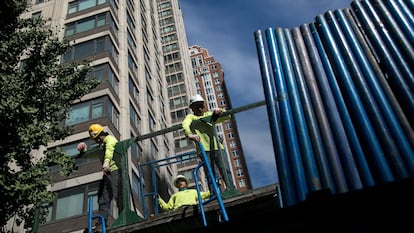Trump’s proposed limits on immigration threaten the US economy
Immigrants represent 20% of the workforce, spread across a dozen categories

Two men speak softly in Spanish in one of the cars of the A line of the New York City Subway. Weighed down by large backpacks — construction helmets hanging from the side — they’re heading into Manhattan. A third man takes advantage of the commute to rest his eyes as he heads in from Brooklyn. Nearby, two women — wearing the uniforms of healthcare workers — scroll through their phones and make comments to each other: one has a Latin accent, the other Jamaican.
It’s 5.30 a.m. on a workday in the spring. The train is a small sample of a country that fills a high percentage of its jobs with applicants who arrive from beyond the borders of the United States.
Figures from the Bureau of Labor Statistics (BLS) show that, in April of 2024, immigrants represented 19.2% of the US workforce. That’s a record and an increase of two percentage points from before the pandemic. But the true figure may be even higher. “There are projections from the Congressional Budget Office (CBO) and other studies that suggest that the growth of the non-native labor force has been stronger than what’s captured by the BLS data,” says Nancy Vanden Houten, chief economist for the US at Oxford Economics.
The group has just published a study in which she assesses the economic impacts of the proposals put forward by Republican presidential candidate Donald Trump. This is in the event that he wins another term and imposes stronger limits on both legal and irregular immigration. The former president has promised to deport 11 million people should he be elected in November. “In that scenario, annual net immigration would be about 560,000 people a year… about half of the current 1.1 million,” Vanden Houten explains.
The impact in terms of employment would be very notable for entire job categories, especially in the coastal states — including Alaska — and Texas. If immigration were to be strongly restricted, “labor would be lost in a wide range of activities, from computing and mathematics to the maintenance of buildings,” the economist warns. Upon tabulating the figures that the BLS has up until 2022, the expert says that the representation of these workers in many sectors is truly surprising. In fact, the percentages may be even higher than what the figures capture.
With the exception of personal assistance — care of those who are elderly, sick, or living with disabilities — and the agriculture, fishing and forestry sectors (which haven’t fully recovered since the pandemic), the presence of immigrant workers in other job categories is, today, higher than what it was before the COVID-19 pandemic. In the case of computing and mathematics, 26.5% of the workers weren’t born in the US, while 24.4% of workers in the life, physical and social sciences are foreign-born, including biologists, seismologists, pathologists, geneticists and economists. The figure stands at 23.9% when looking at those who hold jobs in the healthcare support sector.
In the food preparation and service industry, 23.2% of workers are foreigners, while four out of 10 employees in building and property maintenance are also foreigners. In the construction and mining sectors, of every 10 workers, almost 3.5 of them are non-native. And in the case of the two categories that — just two years ago — were below the 2019 levels, one in five personal caregivers are from outside the United States, as are 36.6% of those who work in farms, fishing and forest management.
Just over half of these immigrant workers — 15 of the 28 million — have become naturalized citizens. However, according to the American Community Survey (ACS) — conducted by the U.S. Census Bureau — the rest are workers with and without legal documentation. “Industries that rely on these workers could be hit harder by crackdowns on illegal immigration,” Vanden Houten notes. Meanwhile, others will suffer if new visa limits are imposed. Some jobs will be open to foreign applicants, but others won’t. And, if these limitations are confirmed, they’ll be imposed when there’s already a shortage of workers.
In a study that was published last year, Madeline Zavodny — an economics professor at the University of North Florida — explained that layoffs in certain high-tech industries and concerns about the impact of artificial intelligence “obscure America’s continuing need for additional workers at the top and bottom of the skill distribution. International migration is the only potential source of growth in the U.S. working-age population in the coming years.”
Her calculations suggest that — without a continued arrival of immigrants — the working-age population will decrease in the next two decades and, by 2040, there will be six million fewer workers than in 2022.
Zavodny rejects claims that migrants negatively affect the employment opportunities of American-born individuals and points to the experience of recent years, in which the employment rate of this group has also skyrocketed. “The percentage of [native-born Americans] who are employed has surpassed the pre-pandemic rate and is at its highest level in 20 years,” she adds. Furthermore — with an eye to recent legislation, such as the CHIPS Act and the Inflation Reduction Act, intended to bolster high-tech industries in the country — Zavodny points out that, in the medium-term, “domestic workers are unlikely to be sufficient to meet labor demand as federally-funded infrastructure projects roll out and domestic semiconductor production ramps up.”
According to the study by Oxford Economics, half of the 10 occupations expected to see stronger employment growth in the future “rely disproportionately on foreign workers.” These include roles in the healthcare sector, computing and mathematics, the physical and social sciences, homecare and transportation.
“I don’t want to get into [politics], but restricting immigration doesn’t make sense when you need workers… a need that will be greater as the population ages,” Vanden Houten affirms. This economist admits that the immigration system needs fixing, but that the issue “has become very politicized and we’ve lost sight of the benefits that the CBO and the Federal Reserve have pointed out,” such as the potential for economic growth and lower inflation.
Zavodny goes even further, arguing that a population decline will lead the economy to long-term stagnation “and even contraction.” In this crucial election year in the United States, the hegemonic discourses surrounding two central issues — the economy and immigration — are on the verge of colliding.
Sign up for our weekly newsletter to get more English-language news coverage from EL PAÍS USA Edition
Tu suscripción se está usando en otro dispositivo
¿Quieres añadir otro usuario a tu suscripción?
Si continúas leyendo en este dispositivo, no se podrá leer en el otro.
FlechaTu suscripción se está usando en otro dispositivo y solo puedes acceder a EL PAÍS desde un dispositivo a la vez.
Si quieres compartir tu cuenta, cambia tu suscripción a la modalidad Premium, así podrás añadir otro usuario. Cada uno accederá con su propia cuenta de email, lo que os permitirá personalizar vuestra experiencia en EL PAÍS.
¿Tienes una suscripción de empresa? Accede aquí para contratar más cuentas.
En el caso de no saber quién está usando tu cuenta, te recomendamos cambiar tu contraseña aquí.
Si decides continuar compartiendo tu cuenta, este mensaje se mostrará en tu dispositivo y en el de la otra persona que está usando tu cuenta de forma indefinida, afectando a tu experiencia de lectura. Puedes consultar aquí los términos y condiciones de la suscripción digital.
More information
Archived In
Últimas noticias
Luisa Neubauer, climate change activist: ‘Ecology shouldn’t be a punitive force, but a joyful and liberating one’
Trump followed CIA recommendation to hand power to Delcy Rodríguez due to risk that Machado would not control the army
The Motherwell painting that Franco wanted to hide from view
Mexico seeks to shore up its defenses following US incursion in Venezuela
Most viewed
- Alain Aspect, Nobel laureate in physics: ‘Einstein was so smart that he would have had to recognize quantum entanglement’
- Alvin Hellerstein, a 92-year-old judge appointed by Bill Clinton, to preside over Maduro’s trial in New York
- Cuba confirms death of 32 of its citizens in the US attack against Venezuela
- Gilles Lipovetsky: ‘If you want to live better and fall in love, take Prozac, don’t look to philosophy’
- Why oil has been at the center of Venezuela-US conflicts for decades











































